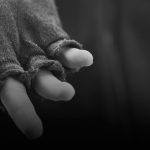At The Gospel Coalition, we believe that the gospel drives us to do justice and to love mercy. As our Theological Vision for Ministry reads, “God created both soul and body, and the resurrection of Jesus shows that he is going to redeem both the spiritual and the material. Therefore God is concerned not only for the salvation of souls but also for the relief of poverty, hunger, and injustice. . . . Christian churches must work for justice and peace in their neighborhoods through service even as they call individuals to conversion and the new birth. We must work for the eternal and common good and show our neighbors we love them sacrificially whether they believe as we do or not. Indifference to the poor and disadvantaged means there has not been a true grasp of our salvation by sheer grace.”
A version of this article first appeared Ethics and Religious Liberty Commission (ERLC) website.
Everyone is looking to be loved. Anna was no exception. While still in her late teens, she met and fell in love with an older man who gave her what she craved. Could he be the one to love and accept me for who I am? she wondered. This longing for love made her vulnerable to her “boyfriend,” who had different plans for their “relationship”. Over the ensuing months, she would be subtly manipulated into becoming part of his special “art project.” Unknowingly, she was trafficked into the world of pornography.
Human trafficking exists when the vulnerable are exploited for commercial gain. Whether we know it or not, though, this problem affects us all. According to Walk Free, an anti-slavery group, as many as 36 million people are modern-day slaves. And it’s not just an overseas problem. With cases reported in all 50 states in the U.S., slavery happens across the street from where we live, work, and worship. Those vulnerable to human trafficking include the man being forced to work against his will in a brick mill in India as well as the 17-year-old girl in the back pew of church being trafficked for sex by her boyfriend.
The Local Church as Safe Haven
As Anna shared her story with me, I couldn’t shake a nagging question. “How did the local church serve you during your exploitation?” I asked her. Hearing my question, she laughed out loud. “For years,” she replied, “I went to church regularly. No one noticed anything. Everyone thought I was happy, so nothing wrong could be going on.”
Sadly, Anna’s story is not uncommon. Amanda Eckhardt, director of programs at Restore NYC, who works with about 200 sex trafficking survivors a year, says that many of their clients have been allowed by their traffickers to attend church services. Many even attend faith communities regularly. Others in the anti-trafficking movement confirm what Eckhardt has observed, saying that the local church is one of the few places where trafficking victims can be away from their exploiters.
This is good news, right? Especially since the church has been called to care for “the least of these.” This phrase comes from what has become known as the Parable of the Sheep and Goats (Matt. 25:31–46), where Jesus sits as Judge at the final judgment saying to those on his right, the sheep: “Come, you who are blessed by my Father, inherit the kingdom prepared for you from the foundation of the world” (Matt. 25:34). Why? “Because I was hungry and you fed me. I was naked and you clothed me. I was in prison and you showed me hospitality” (Matt. 25:35–37). “As you did it to one of the least of these my brothers, you did it to me,” he explains (Matt. 25:40). Those on his left, the goats, however, are cursed and condemned because these works of mercy and compassion didn’t accompany true faith.
The Least of These
Though this text is often used as an imperative for the local church to care for all vulnerable people, there are many who disagree. The “least of these, my brothers” in Matt. 25:40, they explain, refers specifically to vulnerable and exploited Christians. If this is true, then why aren’t we telling, and hearing, more stories like Anna’s?
If we’re honest with ourselves, it’s because we’re not looking for the vulnerable—not even in our midst. For whatever reason, we fail to see what’s hidden in plain sight. How can the local church be the hands and feet of Jesus Christ if we aren’t being his eyes and ears, too? How can we love someone if we don’t even know they exist?
Here are five places to start:
- Pray. As we begin to pray for the vulnerable in the community, our eyes will begin to open. As we repent of not actively caring, we will be given opportunities to care. As we pray for the traffickers, the trafficked, and those who purchase sex, we will be moved to action. Our God is a God of justice, and he loves the weak and vulnerable more than we ever could comprehend.
- Stand on the gospel. With Christ, we see the King of Glory coming to a broken world and becoming vulnerable—to the point of death—to save the vulnerable. As we continue to think about how he came to us when we had nothing to offer but our own brokenness and vulnerability, our hearts will be broken for others. We will find we will love naturally, as we remember how much we are loved.
- Become aware of human trafficking. Awareness is much more than knowing trafficking exists. It’s knowing how to identify and respond to those being exploited. To do this, we need to learn the red flags of human trafficking.
- Respond. A great way to respond is by putting the National Human Trafficking Hotline number in our phones: 1-888-373-7888. When you call the hotline, you will be greeted by someone who desires to help you care for those who may be being exploited. They will take the information that you give and pass it along to the proper authorities in your community.
- Get to know other church members. We never know how people are struggling from week-to-week. Fighting human trafficking, then, can begin with an act as simple as listening to someone’s story. As we get to know one another and build deeper relationships within the church, we are better positioned to recognize and respond with our hearts and eyes wide open.
Anna found help from Christians whose eyes were open. It was through her time at Mercy Ministries, a Christian residential program working with young women, that she realized her identity did not rest in her exploitation but in Christ, who was for her. In addition to her work with policy and law, Anna is currently a designer whose burgeoning fashion line is aptly called “Freedom is the New Beautiful.”
As she shares her story now, she doesn’t refer to herself as a survivor of human trafficking so much as an overcomer. Anna, who was vulnerable and looking for love, found the love she desired in the person of Jesus Christ. As those who share in this love, let us notice those who are vulnerable—even if they are sitting in the back row of our own congregations and appear as if nothing’s wrong.
Is there enough evidence for us to believe the Gospels?
 In an age of faith deconstruction and skepticism about the Bible’s authority, it’s common to hear claims that the Gospels are unreliable propaganda. And if the Gospels are shown to be historically unreliable, the whole foundation of Christianity begins to crumble.
In an age of faith deconstruction and skepticism about the Bible’s authority, it’s common to hear claims that the Gospels are unreliable propaganda. And if the Gospels are shown to be historically unreliable, the whole foundation of Christianity begins to crumble.

































